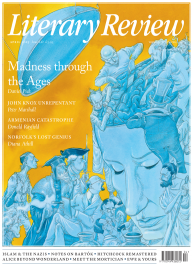Donald Rayfield
Ghosts of Anatolia
‘They Can Live in the Desert but Nowhere Else’: A History of the Armenian Genocide
By Ronald Grigor Suny
Princeton University Press 490pp £24.95
Great Catastrophe: Armenians and Turks in the Shadow of Genocide
By Thomas de Waal
Oxford University Press 298pp £20
Fragments of a Lost Homeland: Remembering Armenia
By Armen T Marsoobian
I B Tauris 342pp £22.50
The extent of the Armenian genocide (at a sober estimate, half of the 1.5 million Armenians of Constantinople and Anatolia were slaughtered) carried out by Turks in 1915 was dwarfed by the Holocaust inflicted by the Nazis and their allies between 1941 and 1945, but the horror of the events and the festering political consequences are just as great. Yet recognition of the Armenian genocide is less widespread and more often denied than the extermination of Europe’s Jews. The literature alone is sparse and mostly academic: to date the most moving account is Franz Werfel’s fictional The Forty Days of Musa Dagh. However, the centenary of the genocide is being marked by three fine and very different studies. It is to be hoped that they will be published not only in English but in Turkish (Azeri and Ottoman) and Armenian too.
Ronald Suny is the grandson of a woman who escaped the slaughters of Armenians ordered by Sultan Abdülhamid II in 1895, and at the same time a polyglot historian best known for his work on Georgia. Among the admirable qualities of his history are its restraint and objectivity. He refrains

Sign Up to our newsletter
Receive free articles, highlights from the archive, news, details of prizes, and much more.@Lit_Review
Follow Literary Review on Twitter
Twitter Feed
How to ruin a film - a short guide by @TWHodgkinson:
Thomas W Hodgkinson - There Was No Sorcerer
Thomas W Hodgkinson: There Was No Sorcerer - Box Office Poison: Hollywood’s Story in a Century of Flops by Tim Robey
literaryreview.co.uk
How to ruin a film - a short guide by @TWHodgkinson:
Thomas W Hodgkinson - There Was No Sorcerer
Thomas W Hodgkinson: There Was No Sorcerer - Box Office Poison: Hollywood’s Story in a Century of Flops by Tim Robey
literaryreview.co.uk
Give the gift that lasts all year with a subscription to Literary Review. Save up to 35% on the cover price when you visit us at https://literaryreview.co.uk/subscribe and enter the code 'XMAS24'